For Sale: Twelve wooded Knowlton Township acres with Delaware River frontage. Commercial highway location. Tavern, barn, cottage, drained pond, smokehouse and shed included. Other remnants on-site. Abandoned railroad nearby. Needs work.
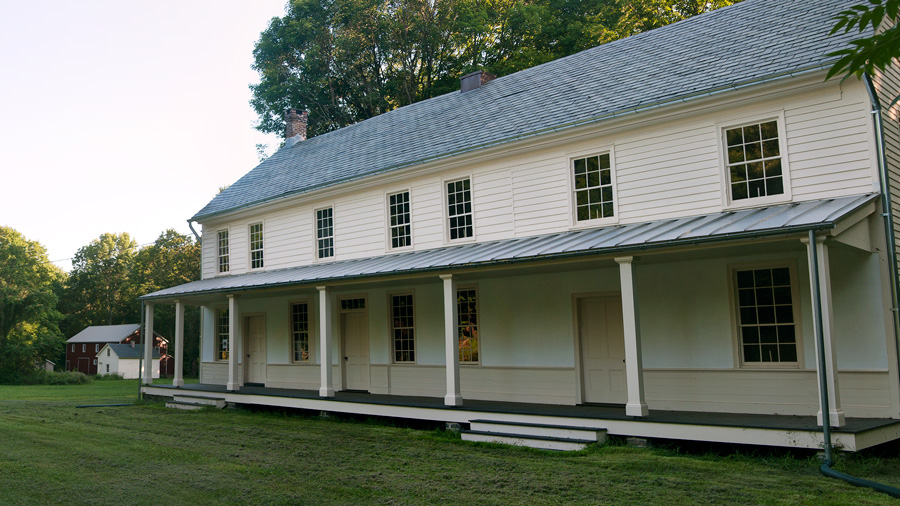
Sounds good? The Knowlton Township Historic Commission thought so. Neglected, vandalized and forgotten, the ruins of the historic hamlet of Ramsaysburg wouldn’t have held much significance for typical house hunters. But KTHC members, led by Chairperson Hal Bromm and Historic Preservation Advisor Dennis Bertland, recognized the significance of the irreplaceable and relatively untouched complex structures built from 1800 – 1870.
Saving Ramsaysburg required state, county and local funding, as well as extensive research to support listing the site on the New Jersey and the National Register of Historic Places. In a recent presentation at the Land Trust Rally, Bromm referred to Ramsaysburg as an example. "Without the tavern, barn, tenant house, smokehouse and other structures, the 12 acre site at Ramsaysburg would be just another bucolic greenway along the banks of the Delaware River. With the structures stabilized, preserved and recycled with adaptive new arts and culture uses, these structures will bring life and meaning to both the site and its river-trade history,” Bromm said.
Green Acres acquired the property in 2000 to become a part of the Beaver Brook Wildlife Management area, overseen by the Division of Fish and Wildlife. But the Department of Environmental Protection was unable to maintain or protect any of the structures of the hamlet. KTHC members worked with the Township of Knowlton to arrange a lease of the property from the DEP. Plans to restore the site and to utilize it as a heritage tourism attraction were given life with a $5,000 grant from the Warren County Cultural and Heritage Commmission.
Securing listings on the Registers afforded the property recognition, some protection, and led to its nomination on the Ten Most Endangered Historic Sites in New Jersey by Preservation New Jersey in 2002. KTHC members secured approximately $200,000 to stabilize the buildings from the Delaware River Greenway and the Warren County Municipal and Charitable Conservancy Trust Fund. Another $40,000 grant came from the New Jersey Historic Trust.
With a twenty year lease finally in place in 2004, the KTHC began cleaning up the site and initiated plans for restorations on the roof, structure and masonry on the main homestead building,
Catering to both road and river traffic and commerce, the tavern and about 50 acres along the Delaware River in newly-formed Knowlton Township appealed to brothers James and Adam Ramsay in 1795. The prime location, complete with a tributary cascading from the mountains into the Delaware River, held unlimited potential. As James became a prominent political figure, serving as County Freeholder as well as on the Knowlton Township Committee, the hamlet of Ramsaysburg, solely owned by James since 1801, prospered.
A Post Office was established in 1827, followed by the tavern, a store, an Episcopal Church and several homes by 1834. Census records show an extended Ramsay family living at the homestead site, along with several tenant families. A hotel was shown as operating at the site in 1852, and the "Ramsay and Swayze” lumberyard, complete with a sawmill, was advertised in local newspapers as early as 1850. A blacksmith shop was also located on the Ramsay property.
The Ramsay family heirs retained ownership of the entire property until 1885, when a portion was sold. The remainder was lost in a court-ordered sale in 1950. Both portions apparently became owned or managed Myron Gilbert, who successfully ran the Spring Brook Farm Hotel resort, begun by a previous owner in 1901, after the sale of the first portion of the Ramsaysburg property. Gilbert is said to have run the resort for many years. The hotel, along with some of its original property, was sold in 1987 to new owners, whose plans to open a bed-and-breakfast there were dashed when the building was destroyed by a 1997 fire.
The site of the Ramsaysburg homestead retains buildings and ruins representing the activity that occurred during its heyday, from 1795-1874. Over this eighty-year period, the Ramsay family grew and thrived, serving the community with a tavern, store, post office, sawmill, blacksmith and hotel. The river supplied transportation for the logs the sawmill and lumberyard needed, and the power of its tributary powered the mill. They took advantage of the main road and opened a hotel, which also capitalized on the appeal of the river. The family supported several tenants, including those who farmed the land, and likely employed several servants. Little modernization was done to the remaining buildings, leaving them significant as examples of early architecture.
The Ramsaysburg Farmstead Tavern House is the prominent building fronting Route 46 westbound. Built in two parts, the original portion is dated circa 1800. It is at once typical of the average construction of its era, and atypical in its form and function. Built as a tavern/store and a dwelling place, the original portion of the homestead was definitely a multi-use structure. It is unknown whether this was common practice at the time, as only several other examples of such buildings have survived, according to Bertland. With two entrance doors, it is believed that one door served the residence, and the other accessed the business. Built with traditional timber-frame construction, it has straw and mud nogging in the outside walls. Although they are now removed, the building was a rare example of a center-hall plan with an internal chimney serving corner fireplaces. One other example of this design exists locally, in Belvidere. Distinctive cut nails, circa 1790-1820, were used to attach the beaded clapboard siding.
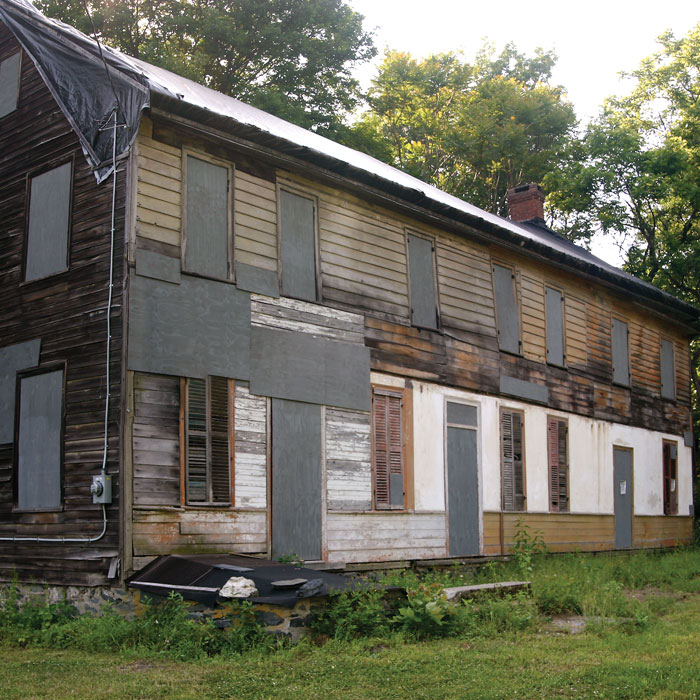
With other Georgian-style details, along with Greek Revival characteristics in the newer addition, the Tavern House incorporates a time line of traditional construction patterns, including the late 1800s louvered shutters and slate roofing. Other features such as chair rail which "steps down” under the windows on the second floor, random width flooring, plaster walls, panel door, two staircases and a large (now bricked over) cooking fireplace and recessed paneled doors with butt hinges are reminders of early craftsmanship.
"Taverns played a huge role in any community. That is where people would go to meet with friends and neighbors and hear the latest news. Most were farmers around here. They worked hard. Very hard. It was a place to go to take a break. Perhaps it can be that way again. Much needs to be done, but there are great possibilities for Ramsaysburg,” said former KTHC member Jon Bellis, reflecting on the past and the potential future of the site.
The English-style barn with a gable roof and three bays, is dated to 1850-70 based on the hemlock timber construction. It is believed that the hemlock was rafted down the Delaware to the sawmill. The barn does have a poured concrete floor, which is a twentieth century improvement. Other structures remaining on the property are the cottage, circa 1860, and the smokehouse from the same era. A wagon shed dates slightly later, to 1880 or so. The drained pond/dam ruins and the site of the burned hotel offer archeological interest.
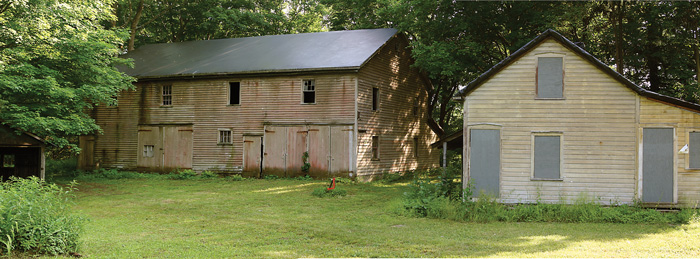
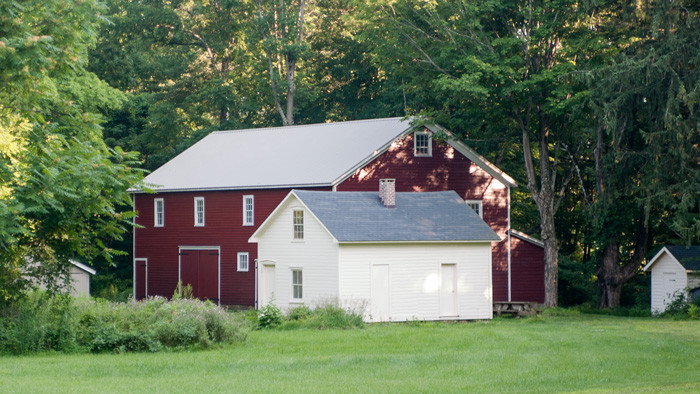
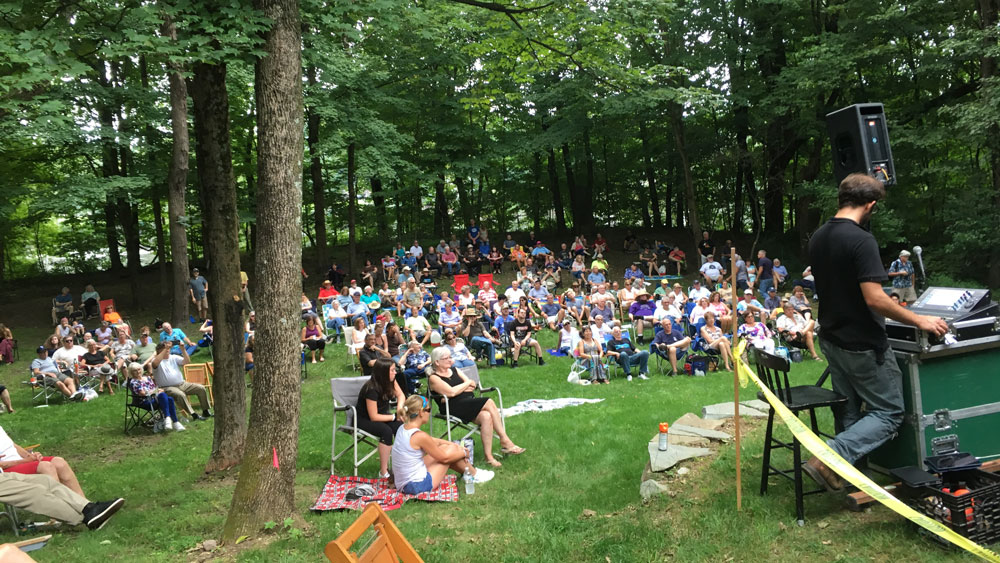
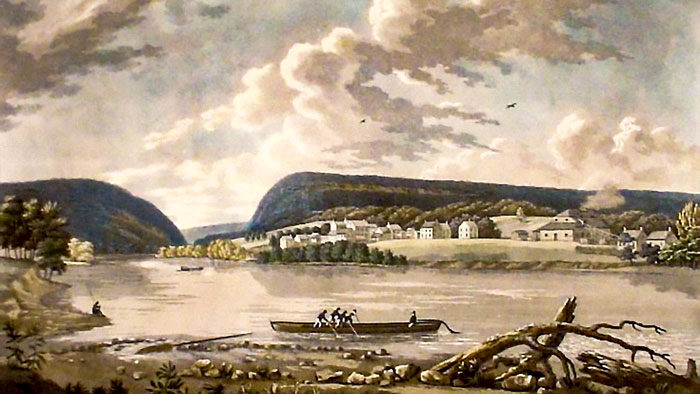
As Ramsay’s hamlet grew, the Columbia Glassworks became a thriving economic force a few miles north, where employees established residences and visitors came to see the glass blowers. A ferry provided passage across the Delaware to Portland, PA, and several hotels opened in the early 1800s along with a grocery, several taverns and the Knowlton Mills. A lumber store and the Columbia Post Office, along with a church and an octagonal schoolhouse, completed the village. But even before those who conceived of the bridge across the river were able to raise the money for its construction, the Columbia Glassworks shut down, in 1825, and the town declined. But by 1886 – despite the construction of the bridge over the Delaware River in 1869 – Columbia had become a sleepy residential hamlet.
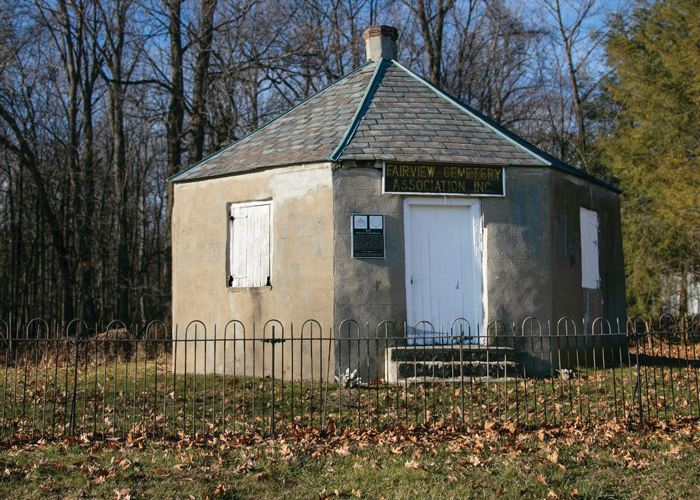
The Columbia-Portland Pedestrian Bridge, known locally as the “walking bridge,” was assembled in 1957 on the site of an earlier bridge built under cover in 1869. The last of sixteen of its kind that once graced the Delaware River, this was also the longest covered bridge in the United States, spanning 775 feet between New Jersey and Pennsylvania. Originally constructed for vehicular traffic, catering first to the conveyance of livestock then to automobile traffic, the bridge was consigned to foot traffic upon the opening of the Portland-Columbia Toll Bridge a quarter mile downstream in 1953. The old bridge withstood nearly a century of wind, rain and floods before succumbing to the fury of Hurricane Diane in August, 1955. Looking upriver, the imposing profile of the Delaware Viaduct is plainly visible beneath the contours of the Water Gap. It was completed in 1910, one of two massive bridges in Knowlton along the Lackawanna Cut-Off rail line. A shorter distance upstream another bridge once serviced the Lehigh and New England Railroad from an elevated track through Columbia, across enormous concrete pedestals that still stand at the river bank. Two miles downstream, the now-abandoned Delaware Trestle was built in 1902 to service the Warren Railroad out of Delaware station along the Lackawanna old road.
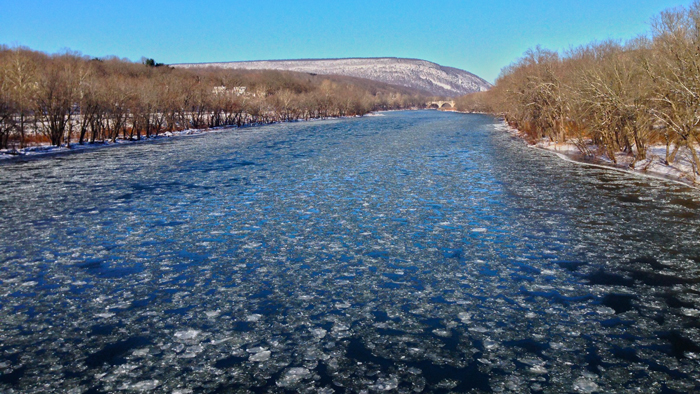
In the mid 1800s the village of Delaware was established by local businessman John I. Blair for the purpose of serving as a terminus for the Warren Railroad, built in the 1850s. Blair intended to link the railroad to the Pennsylvania coalfields and the New York markets by providing a connection between the Central Railroad near Hampton and the Delaware Water Gap. Blair laid out the streets, and built a hotel, store and train station in 1856 that turned the town into a commercial center and a main shipping point for local agricultural products. The railroad also brought tourists to town, capitalizing on its proximity to the Delaware Water Gap, the river, and the surrounding woods and fields.
It was the railroad station at Delaware which significantly impacted Ramsaysburg as river traffic lost prominence. Only one mile apart, the two hamlets led distinctly different lives: as Delaware thrived, Ramsaysburg declined.
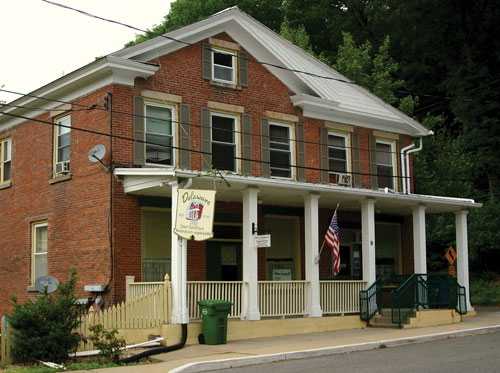
Delaware flourished until 1920, with a succession of factories providing employment and commerce, until the "Lackawanna Cutoff” opened in the early 1900s, by-passing the village and crossing the Delaware and Paulinskill Rivers via the majestic viaducts in the most direct route possible. The Cutoff, located several miles away, made the railroad through Delaware obsolete. Even with State Route 5, now known as Route 46, passing just outside the village, commerce declined and this village, too, became a residential hamlet.
Delaware also has successfully been placed on the State and National Registers of Historic Places thanks to the organization’s efforts. Remnants of the glory days of railroad and of the original Route 5 serve today as reminders of the past, as do the intact commercial-turned-residential buildings and original homes representing vernacular rural architecture of the 1855-1900.
"Preserving farmland and open space, without the structures and houses that define their earliest development and historic use, denies future generations an understanding of how the land was used and why the landscapes-shaped and formed by generations of farming history-look as they now appear,” Bromm says. "The disgraceful loss of numerous historic structures- many historic farmsteads, barns and farmhouses that form the backbone of New Jersey’s rapidly disappearing rural agricultural heritage- has come while the lands beneath them have been saved as open space.”
Ramsaysburg is just the beginning for this ambitious and dedicated group of volunteers. A historic sites and features survey of the Township is being pursued, and will be included in the updated Environmental Resource Inventory, which guides the municipal land use ordinance decisions. Historic structures in Knowlton Township now have a fighting chance to retain their rightful place in history, continuing to grace the landscape, honoring those whose lives were lived during eras too easily forgotten.
The Ramsaysburg Homestead is located close to the Delaware Water Gap at 140 Rt. Route 46 in Knowlton Township. To learn more about Ramsaysburg, or the Friends of Ramsaysburg, please check their website.
The Centenary Stage Company produces professional equity theatre and also a wide variety of top-flight musical and dance events throughout the year.
The 8,461 acre park includes the 2500-acre Deer Lake Park, Waterloo Village, mountain bike and horseback trails.
Local roots!
Consider Rutherfurd Hall as refuge and sanctuary in similar ways now, as it served a distinguished family a hundred years ago.
Choose and Cut from 10,000 trees! Blue Spruce, Norway Spruce, White Pine, Scotch Pine Fraser Fir, Canaan fir, Douglas Fir. Family run on preserved farmland. Open Nov 29 - Dec 23, Tues-Sunday, 9-4. Easy Access from Routes 78 or 80.